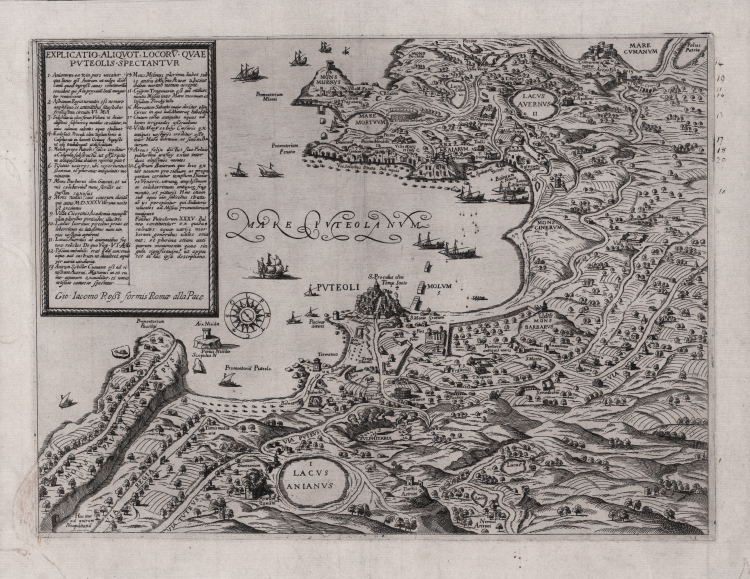



| Reference: | S30073 |
| Author | Francesco VILLAMENA |
| Year: | 1620 ca. |
| Zone: | Campi Flegrei |
| Printed: | Rome |
| Measures: | 345 x 255 mm |


| Reference: | S30073 |
| Author | Francesco VILLAMENA |
| Year: | 1620 ca. |
| Zone: | Campi Flegrei |
| Printed: | Rome |
| Measures: | 345 x 255 mm |
The work is based by Mario Cartaro map of the area (1584) and its subsequent derivations by Duchetti, Cartaro himself and Van Aelst.
Compared to all these maps is slightly smaller format, with a scale of miles, however absent, greater. The orientation is provided in the sea by a compass rose. The legend, which is contained in the title block at the top left is almost identical to this legend in the first version of map Cartaro.
First printed around 1620, the map bear the address of Gian Giacomo de Rossi with the suffix Alla Pace, in use by the Roman typography to 1649. Taken from "Ager Puteolanus sive prospectus eiusdem insignores. Illustrissimo Antonio Roccio optime de se merito dicabat" printed in 1652.
The map is described the "Indice delle Stampe" by Lorenzo Filippo de Rossi (1735) as the "Territorio di Pozzuolo co’ suoi luoghi antichi, in foglio reale". And it is known, described as anonymous, in a example at the National Library of France in Paris and one at the National Library of Malta.
Printed on paper with watermark " lily in the circle with the crown". Magnificent example of this map of great rarity, in excellent conditions.
|
Anna Grelle Iusco, Indice delle Stampe De Rossi, p. 158, 18; Johnston-Lavis 107; vgl. Cicognara 4321 (EA. 1620).
|
Francesco VILLAMENA (Assisi, 1564 - Roma, 7 Luglio 1624)
|
Italian engraver. According to tradition, he was a pupil of Cornelis Cort, whose engravings he copied, and was associated in his youth with Agostino Carracci. He made few original engravings but reproduced designs of artists including Raphael, Paolo Veronese, Federico Barocci, Girolamo Muziano and Giulio Romano. His output also included frontispieces and book illustrations. Closely related to such northern late adherents of Mannerism as Hendrick Goltzius and Jacques Bellange, he employed an elegant and expressive calligraphic style with perfect control of the burin. In addition to religious and historical subjects, he executed portraits, notably a series of genre figures (Rome, Gab. N. Stampe). In 1594 he executed a series of engravings illustrating scenes from the Life of St Francis. His oeuvre comprised at least one hundred plates.
|
|
Anna Grelle Iusco, Indice delle Stampe De Rossi, p. 158, 18; Johnston-Lavis 107; vgl. Cicognara 4321 (EA. 1620).
|
Francesco VILLAMENA (Assisi, 1564 - Roma, 7 Luglio 1624)
|
Italian engraver. According to tradition, he was a pupil of Cornelis Cort, whose engravings he copied, and was associated in his youth with Agostino Carracci. He made few original engravings but reproduced designs of artists including Raphael, Paolo Veronese, Federico Barocci, Girolamo Muziano and Giulio Romano. His output also included frontispieces and book illustrations. Closely related to such northern late adherents of Mannerism as Hendrick Goltzius and Jacques Bellange, he employed an elegant and expressive calligraphic style with perfect control of the burin. In addition to religious and historical subjects, he executed portraits, notably a series of genre figures (Rome, Gab. N. Stampe). In 1594 he executed a series of engravings illustrating scenes from the Life of St Francis. His oeuvre comprised at least one hundred plates.
|